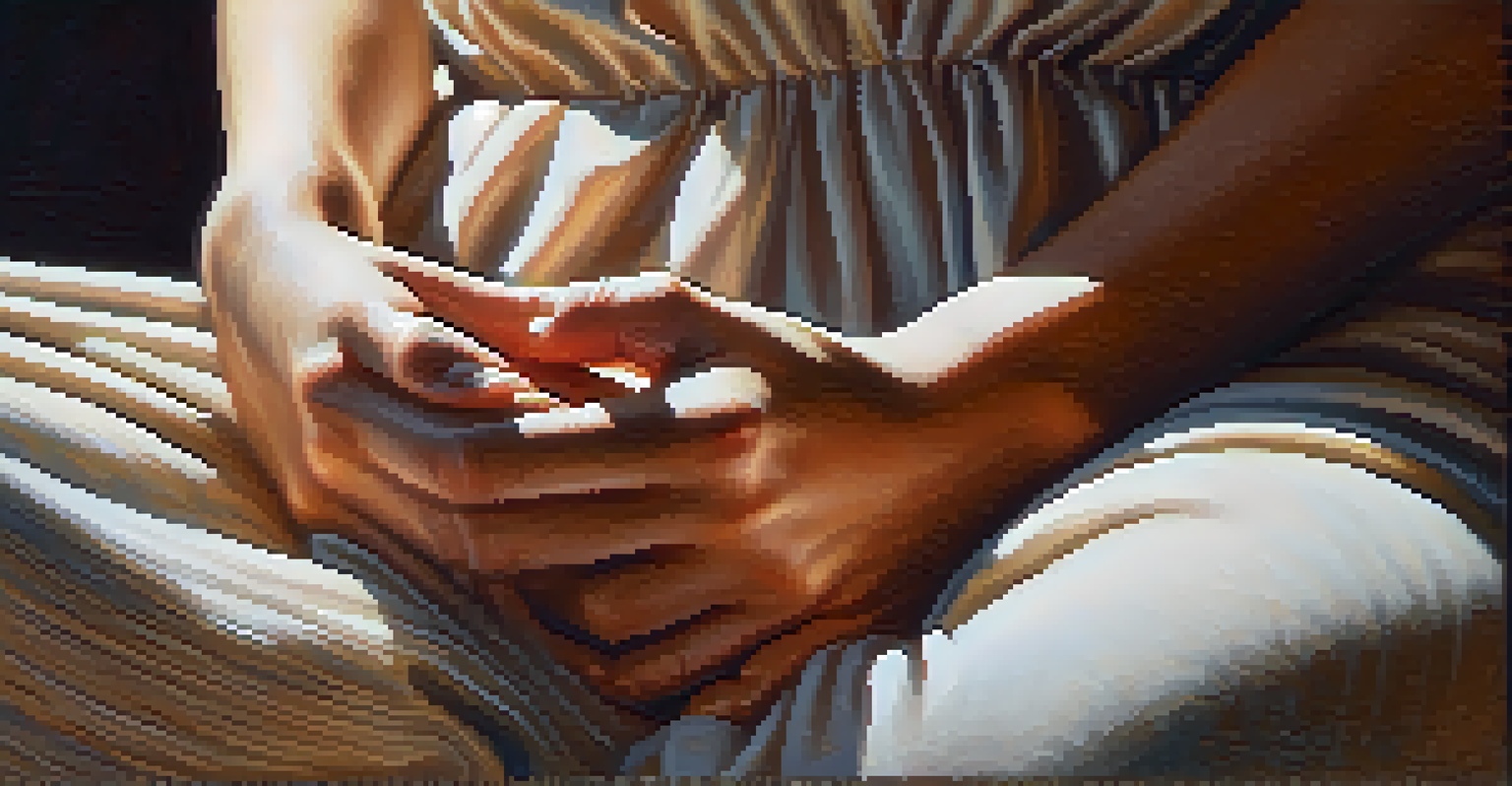The Benefits of Somatic Awareness in Ayahuasca Experiences

Understanding Somatic Awareness in Ayahuasca Contexts
Somatic awareness refers to the ability to tune into your body's sensations and feelings. In the context of Ayahuasca, this awareness can deepen your understanding of the experiences you undergo during the journey. By recognizing physical sensations, you can better navigate the emotional and spiritual landscapes that arise.
The body is a resource for understanding, not just a vessel for carrying our minds.
This practice encourages participants to be present with their bodies, allowing them to experience each moment fully. When you acknowledge what your body is telling you, you can process emotions and insights more effectively, leading to a richer Ayahuasca experience. Ultimately, somatic awareness serves as a bridge between the body and mind, facilitating a holistic journey.
Additionally, cultivating somatic awareness can help ease discomfort during intense moments. Many participants report feeling overwhelmed at times, but by focusing on bodily sensations, they can ground themselves and find calm. This connection can transform potentially challenging experiences into opportunities for growth and healing.
Enhancing Emotional Release through Somatic Practices
One of the key benefits of somatic awareness during Ayahuasca ceremonies is the ability to facilitate emotional release. When participants become aware of tension or discomfort in their bodies, they can better express and release pent-up emotions. This process can lead to profound breakthroughs and a sense of liberation.

For instance, someone may feel tightness in their chest during a ceremony, signaling unresolved grief. By acknowledging this sensation, they can explore the underlying emotions and allow themselves to cry or express that grief. This release often leads to a lighter emotional state and a sense of clarity afterward.
Somatic Awareness Enhances Healing
Tuning into bodily sensations during Ayahuasca journeys facilitates emotional processing and personal growth.
Moreover, the act of releasing emotions through somatic awareness can lead to increased self-compassion. Participants learn to treat themselves with kindness as they navigate their feelings, fostering a healthier relationship with their emotions. This newfound compassion often extends beyond the ceremony, influencing daily life positively.
Connecting with Inner Wisdom via Body Awareness
Somatic awareness encourages deeper connections with our inner wisdom, especially during Ayahuasca experiences. When we tune into our bodies, we often uncover intuitive insights that guide us on our journeys. This connection can illuminate paths we may not have consciously considered.
Awareness of body sensations can lead to profound healing and transformation.
For example, a participant might feel a gentle pull in a specific direction, both physically and emotionally, leading them to explore a particular memory or thought. By following this inner guidance, they can gain valuable insights about themselves and their life circumstances. This intuitive process can be profoundly transformative.
Furthermore, embracing somatic awareness can also enhance self-trust. When participants learn to listen to their bodies, they cultivate confidence in their own instincts. This trust is invaluable, not just during the Ayahuasca experience, but in everyday decision-making and personal growth.
Grounding Techniques to Enhance Ayahuasca Journeys
Grounding techniques play a crucial role in enhancing somatic awareness during Ayahuasca ceremonies. These practices help participants stay connected to their bodies and the present moment, even during challenging experiences. Simple techniques like deep breathing, visualization, or focusing on physical sensations can be incredibly effective.
For instance, during moments of discomfort, a participant might visualize roots extending from their feet into the earth, anchoring them to the ground. This imagery can create a sense of stability and safety, allowing them to navigate their experiences with greater ease. Grounding techniques can transform overwhelming sensations into manageable experiences.
Grounding Techniques Support Experience
Using grounding practices helps participants remain present and navigate challenging emotions throughout their journey.
Moreover, incorporating grounding practices fosters a sense of safety and openness to the healing process. As participants feel more anchored, they may find it easier to explore difficult emotions or memories. This safety net is essential for allowing the healing potential of Ayahuasca to unfold.
Navigating Physical Sensations During Ayahuasca
Navigating physical sensations during Ayahuasca experiences can be both enlightening and challenging. Somatic awareness helps participants recognize and engage with these sensations, leading to a richer understanding of their journeys. By paying attention to what the body is feeling, participants can uncover deeper emotional and psychological layers.
For example, someone might experience nausea or discomfort, which could be linked to emotional blockages. Instead of resisting these sensations, embracing them can lead to healing insights. This awareness transforms discomfort into a meaningful part of the experience rather than something to dread.
Additionally, this navigation process fosters resilience. As participants learn to work with their physical sensations, they develop coping strategies that serve them well in other areas of life. This newfound resilience can empower them to face challenges outside of the Ayahuasca space with greater confidence.
The Role of Breath in Somatic Awareness
Breath plays a pivotal role in enhancing somatic awareness during Ayahuasca experiences. Conscious breathing allows participants to connect with their bodies, helping them tune into sensations and emotions more profoundly. It serves as a tool for grounding and centering oneself throughout the journey.
For instance, focusing on slow, deep breaths can help ease anxiety and promote relaxation. This practice not only enhances the overall experience but also empowers participants to navigate challenging moments with greater ease. Breath becomes a guide, leading them through the complexities of their journey.
Breath as a Tool for Connection
Conscious breathing enhances somatic awareness, allowing participants to engage more deeply with their experiences.
Moreover, the rhythm of breath can synchronize with the experience, creating a harmonious flow. By aligning breath with bodily sensations, participants can cultivate a deeper sense of presence and awareness. This connection enriches their journeys, allowing for more significant insights and transformative moments.
Integrating Somatic Awareness into Post-Ceremony Reflections
Integrating somatic awareness into post-ceremony reflections is crucial for maximizing the benefits of the Ayahuasca experience. After the ceremony, participants often feel a mixture of emotions, insights, and sensations. By reflecting on these bodily experiences, they can better understand their journeys.
For example, someone might recall feelings of warmth or tension during the ceremony and explore what they signify. This reflection helps solidify the lessons learned and encourages personal growth. Engaging with these sensations can lead to a deeper understanding of oneself and one's emotions.

Additionally, maintaining somatic awareness in daily life can foster ongoing healing. By tuning into bodily sensations regularly, individuals can develop a stronger connection to their emotions and needs. This practice empowers them to continue their growth journey long after the ceremony has ended.